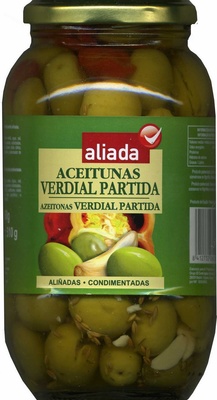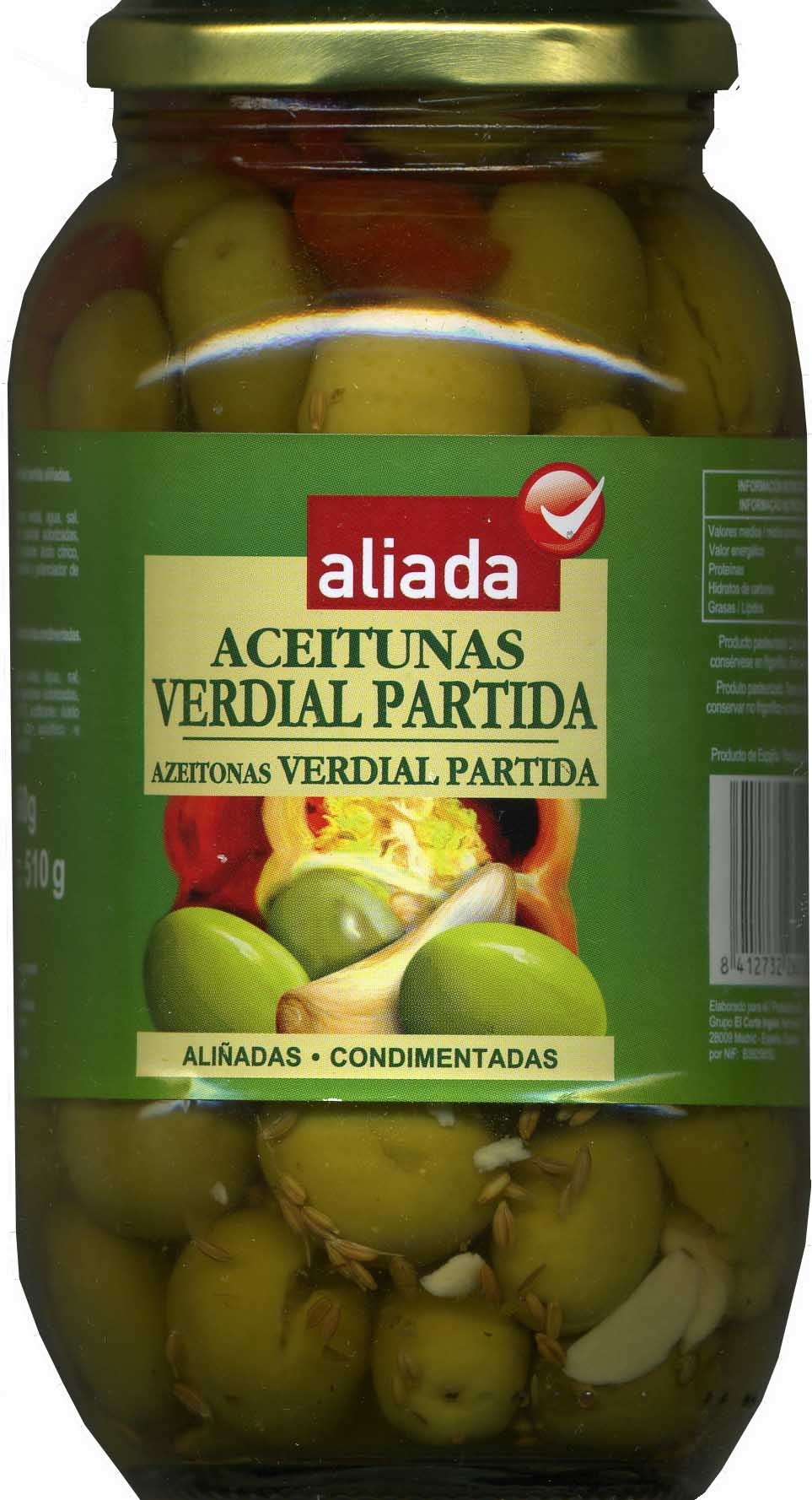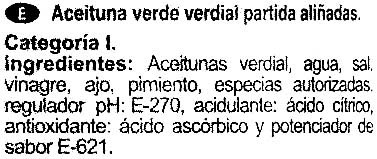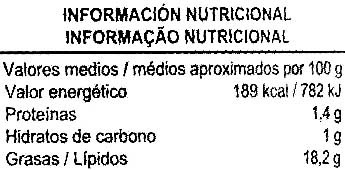Ajuda'ns a fer que la transparència alimentària sigui la norma!
Com a organització sense ànim de lucre, depenem de les vostres donacions per continuar informant els consumidors de tot el món sobre tot allò què mengen.
La revolució alimentària comença amb tu!
Aceitunas verdes partidas aliñadas "Aliada" Variedad Verdial - 860 g (neto), 510 g (escurrido), 850 ml
Aceitunas verdes partidas aliñadas "Aliada" Variedad Verdial - 860 g (neto), 510 g (escurrido), 850 ml
Aquesta pàgina del producte no està completa. Podeu ajudar a completar-la editant-la i afegint-hi més dades a partir de les fotos ja disponibles, o fent-ne més amb l'aplicació de androide o iPhone / iPad. Gràcies!
×
Codi de barres: 8412732260102 (EAN / EAN-13)
Nom comú: Aceitunas verdes partidas aliñadas de la variedad Verdial
Quantitat: 860 g (neto), 510 g (escurrido), 850 ml
Empaquetament: es:Bote de vidrio, es:Pasteurizado
Marques: Aliada
Categories: Aliments i begudes amb base vegetal, Aliments amb base vegetal, Conserves, Productes d'olivera, Conserves vegetals, Olives, en:Cracked olives, Olives verdes, en:Green cracked olives, en:Marinated olives, en:Cracked marinated green olives
Etiquetes, certificacions, premis: Vegetarià
Origen dels ingredients: Espanya
Botigues: Supercor Express, El Corte Inglés
Països on es va vendre: Espanya
Matching with your preferences
Salut
Ingredients
-
19 ingredients
: Aceitunas verdial, agua, sal, vinagre, ajo, pimiento, especias autorizadas, regulador PH: ácido láctico (E-270), acidulante: ácido cítrico (E-330), antioxidante: ácido ascórbico (E-300) y potenciador del sabor: glutamato monosódico (E-621).
Processament d'aliments
-
Aliments ultra processats
Elements que indiquen que el producte està al grup 4 - Aliments i begudes ultraprocessats:
- Additiu: E621 - Glutamat de monosodi
- Ingredient: Potenciador del gust
Els productes alimentaris es classifiquen en 4 grups segons el seu grau de processament:
- Aliments no processats o mínimament processats
- Ingredients culinaris processats
- Aliments processats
- Aliments ultra processats
La determinació del grup es fa en funció de la categoria del producte i dels ingredients que conté.
Additius
-
E270 - Àcid làctic
Lactic acid: Lactic acid is an organic compound with the formula CH3CH-OH-COOH. In its solid state, it is white and water-soluble. In its liquid state, it is colorless. It is produced both naturally and synthetically. With a hydroxyl group adjacent to the carboxyl group, lactic acid is classified as an alpha-hydroxy acid -AHA-. In the form of its conjugate base called lactate, it plays a role in several biochemical processes. In solution, it can ionize a proton from the carboxyl group, producing the lactate ion CH3CH-OH-CO−2. Compared to acetic acid, its pKa is 1 unit less, meaning lactic acid deprotonates ten times more easily than acetic acid does. This higher acidity is the consequence of the intramolecular hydrogen bonding between the α-hydroxyl and the carboxylate group. Lactic acid is chiral, consisting of two optical isomers. One is known as L--+--lactic acid or -S--lactic acid and the other, its mirror image, is D--−--lactic acid or -R--lactic acid. A mixture of the two in equal amounts is called DL-lactic acid, or racemic lactic acid. Lactic acid is hygroscopic. DL-lactic acid is miscible with water and with ethanol above its melting point which is around 17 or 18 °C. D-lactic acid and L-lactic acid have a higher melting point. In animals, L-lactate is constantly produced from pyruvate via the enzyme lactate dehydrogenase -LDH- in a process of fermentation during normal metabolism and exercise. It does not increase in concentration until the rate of lactate production exceeds the rate of lactate removal, which is governed by a number of factors, including monocarboxylate transporters, concentration and isoform of LDH, and oxidative capacity of tissues. The concentration of blood lactate is usually 1–2 mM at rest, but can rise to over 20 mM during intense exertion and as high as 25 mM afterward. In addition to other biological roles, L-lactic acid is the primary endogenous agonist of hydroxycarboxylic acid receptor 1 -HCA1-, which is a Gi/o-coupled G protein-coupled receptor -GPCR-.In industry, lactic acid fermentation is performed by lactic acid bacteria, which convert simple carbohydrates such as glucose, sucrose, or galactose to lactic acid. These bacteria can also grow in the mouth; the acid they produce is responsible for the tooth decay known as caries. In medicine, lactate is one of the main components of lactated Ringer's solution and Hartmann's solution. These intravenous fluids consist of sodium and potassium cations along with lactate and chloride anions in solution with distilled water, generally in concentrations isotonic with human blood. It is most commonly used for fluid resuscitation after blood loss due to trauma, surgery, or burns.Origen: Wikipedia (Anglès)
-
E330 - Acid citric
Citric acid: Citric acid is a weak organic acid that has the chemical formula C6H8O7. It occurs naturally in citrus fruits. In biochemistry, it is an intermediate in the citric acid cycle, which occurs in the metabolism of all aerobic organisms. More than a million tons of citric acid are manufactured every year. It is used widely as an acidifier, as a flavoring and chelating agent.A citrate is a derivative of citric acid; that is, the salts, esters, and the polyatomic anion found in solution. An example of the former, a salt is trisodium citrate; an ester is triethyl citrate. When part of a salt, the formula of the citrate ion is written as C6H5O3−7 or C3H5O-COO-3−3.Origen: Wikipedia (Anglès)
-
E621 - Glutamat de monosodi
Monosodium glutamate: Monosodium glutamate -MSG, also known as sodium glutamate- is the sodium salt of glutamic acid, one of the most abundant naturally occurring non-essential amino acids. Glutamic acid is found naturally in tomatoes, grapes, cheese, mushrooms and other foods.MSG is used in the food industry as a flavor enhancer with an umami taste that intensifies the meaty, savory flavor of food, as naturally occurring glutamate does in foods such as stews and meat soups. It was first prepared in 1908 by Japanese biochemist Kikunae Ikeda, who was trying to isolate and duplicate the savory taste of kombu, an edible seaweed used as a base for many Japanese soups. MSG as a flavor enhancer balances, blends, and rounds the perception of other tastes.The U.S. Food and Drug Administration has given MSG its generally recognized as safe -GRAS- designation. A popular belief is that large doses of MSG can cause headaches and other feelings of discomfort, known as "Chinese restaurant syndrome," but double-blind tests fail to find evidence of such a reaction. The European Union classifies it as a food additive permitted in certain foods and subject to quantitative limits. MSG has the HS code 29224220 and the E number E621.Origen: Wikipedia (Anglès)
Anàlisi dels ingredients
-
No conté oli de palma
No s'han detectat ingredients que continguin oli de palma
Ingredients no reconeguts: es:aceitunas-verdial, es:especias-autorizadas, es:regulador-phAlguns ingredients no s'han pogut reconèixer.
Necessitem la teva ajuda!
Podeu ajudar-nos a reconèixer més ingredients i analitzar millor la llista d'ingredients d'aquest producte i d'altres mitjançant:
- Editeu aquesta pàgina de producte per corregir les faltes d’ortografia de la llista d’ingredients i/o per eliminar els ingredients d’altres idiomes i frases que no estiguin relacionades amb els ingredients.
- Afegiu entrades, sinònims o traduccions noves a les nostres llistes multilingües d’ingredients, mètodes de processament d’ingredients i etiquetes.
Uniu-vos al canal #ingredients del nostre espai de discussió a Slack i/o apreneu sobre l'anàlisi dels ingredients en la nostra wiki, si voleu ajudar. Gràcies!
-
Es desconeix si és vegà
Ingredients no reconeguts: es:aceitunas-verdial, es:especias-autorizadas, es:regulador-phAlguns ingredients no s'han pogut reconèixer.
Necessitem la teva ajuda!
Podeu ajudar-nos a reconèixer més ingredients i analitzar millor la llista d'ingredients d'aquest producte i d'altres mitjançant:
- Editeu aquesta pàgina de producte per corregir les faltes d’ortografia de la llista d’ingredients i/o per eliminar els ingredients d’altres idiomes i frases que no estiguin relacionades amb els ingredients.
- Afegiu entrades, sinònims o traduccions noves a les nostres llistes multilingües d’ingredients, mètodes de processament d’ingredients i etiquetes.
Uniu-vos al canal #ingredients del nostre espai de discussió a Slack i/o apreneu sobre l'anàlisi dels ingredients en la nostra wiki, si voleu ajudar. Gràcies!
-
Vegetarià
No s'han detectat ingredients no vegetarians
Ingredients no reconeguts: es:aceitunas-verdial, es:especias-autorizadas, es:regulador-phAlguns ingredients no s'han pogut reconèixer.
Necessitem la teva ajuda!
Podeu ajudar-nos a reconèixer més ingredients i analitzar millor la llista d'ingredients d'aquest producte i d'altres mitjançant:
- Editeu aquesta pàgina de producte per corregir les faltes d’ortografia de la llista d’ingredients i/o per eliminar els ingredients d’altres idiomes i frases que no estiguin relacionades amb els ingredients.
- Afegiu entrades, sinònims o traduccions noves a les nostres llistes multilingües d’ingredients, mètodes de processament d’ingredients i etiquetes.
Uniu-vos al canal #ingredients del nostre espai de discussió a Slack i/o apreneu sobre l'anàlisi dels ingredients en la nostra wiki, si voleu ajudar. Gràcies!
-
Detalls de l'anàlisi dels ingredients
Necessitem la teva ajuda!
Alguns ingredients no s'han pogut reconèixer.
Necessitem la teva ajuda!
Podeu ajudar-nos a reconèixer més ingredients i analitzar millor la llista d'ingredients d'aquest producte i d'altres mitjançant:
- Editeu aquesta pàgina de producte per corregir les faltes d’ortografia de la llista d’ingredients i/o per eliminar els ingredients d’altres idiomes i frases que no estiguin relacionades amb els ingredients.
- Afegiu entrades, sinònims o traduccions noves a les nostres llistes multilingües d’ingredients, mètodes de processament d’ingredients i etiquetes.
Uniu-vos al canal #ingredients del nostre espai de discussió a Slack i/o apreneu sobre l'anàlisi dels ingredients en la nostra wiki, si voleu ajudar. Gràcies!
: Aceitunas verdial, agua, sal, vinagre, ajo, pimiento, especias autorizadas, regulador PH (ácido láctico (e270)), acidulante (ácido cítrico (e330)), antioxidante (ácido ascórbico (e300)), potenciador del sabor (glutamato monosódico (e621))- Aceitunas verdial -> es:aceitunas-verdial - percent_min: 9.09090909090909 - percent_max: 100
- agua -> en:water - vegan: yes - vegetarian: yes - ciqual_food_code: 18066 - percent_min: 0 - percent_max: 50
- sal -> en:salt - vegan: yes - vegetarian: yes - ciqual_food_code: 11058 - percent_min: 0 - percent_max: 33.3333333333333
- vinagre -> en:vinegar - vegan: yes - vegetarian: yes - ciqual_food_code: 11018 - percent_min: 0 - percent_max: 25
- ajo -> en:garlic - vegan: yes - vegetarian: yes - ciqual_food_code: 11000 - percent_min: 0 - percent_max: 20
- pimiento -> en:bell-pepper - vegan: yes - vegetarian: yes - ciqual_food_code: 20041 - percent_min: 0 - percent_max: 16.6666666666667
- especias autorizadas -> es:especias-autorizadas - percent_min: 0 - percent_max: 14.2857142857143
- regulador PH -> es:regulador-ph - percent_min: 0 - percent_max: 12.5
- ácido láctico -> en:e270 - vegan: yes - vegetarian: yes - percent_min: 0 - percent_max: 12.5
- e270 -> en:e270 - vegan: yes - vegetarian: yes - percent_min: 0 - percent_max: 12.5
- ácido láctico -> en:e270 - vegan: yes - vegetarian: yes - percent_min: 0 - percent_max: 12.5
- acidulante -> en:acid - percent_min: 0 - percent_max: 11.1111111111111
- ácido cítrico -> en:e330 - vegan: yes - vegetarian: yes - percent_min: 0 - percent_max: 11.1111111111111
- e330 -> en:e330 - vegan: yes - vegetarian: yes - percent_min: 0 - percent_max: 11.1111111111111
- ácido cítrico -> en:e330 - vegan: yes - vegetarian: yes - percent_min: 0 - percent_max: 11.1111111111111
- antioxidante -> en:antioxidant - percent_min: 0 - percent_max: 10
- ácido ascórbico -> en:e300 - vegan: yes - vegetarian: yes - percent_min: 0 - percent_max: 10
- e300 -> en:e300 - vegan: yes - vegetarian: yes - percent_min: 0 - percent_max: 10
- ácido ascórbico -> en:e300 - vegan: yes - vegetarian: yes - percent_min: 0 - percent_max: 10
- potenciador del sabor -> en:flavour-enhancer - percent_min: 0 - percent_max: 9.09090909090909
- glutamato monosódico -> en:e621 - vegan: yes - vegetarian: yes - percent_min: 0 - percent_max: 9.09090909090909
- e621 -> en:e621 - vegan: yes - vegetarian: yes - percent_min: 0 - percent_max: 9.09090909090909
- glutamato monosódico -> en:e621 - vegan: yes - vegetarian: yes - percent_min: 0 - percent_max: 9.09090909090909
Nutrició
-
Falten dades per calcular la Nutri-Score
Falten dades nutricionals
⚠ ️S'han d'especificar les dades nutricionals del producte per calcular el Nutri-Score.Podries afegir la informació necessària per calcular el Nutri-Score? Afegir dades nutricionals
-
Nivells de nutrients
-
Greix en Quantitat moderada (18.2%)
Què us cal saber- Un alt consum de greixos, especialment de greixos saturats, pot augmentar el colesterol, que augmenta el risc de patir malalties del cor.
Recomanació: Reduïu el consum de greixos i greixos saturats- Trieu productes amb menys greixos i greixos saturats.
-
-
Informació nutricional
Informació nutricional Com es ven
per 100 g/100 mlComparat amb: en:Cracked marinated green olives Energia 782 kj
(187 kcal)-1% Greix 18,2 g +8% Àcid gras saturat ? Hidrats de carboni 1 g +37% Sucre ? Fiber ? Proteïna 1,4 g +9% Sal comuna ? Fruits‚ vegetables‚ nuts and rapeseed‚ walnut and olive oils (estimate from ingredients list analysis) 4,261 %
Entorn
-
Eco-puntuació A - Impacte ambiental molt baix
El Eco-Score és una puntuació experimental que resumeix els impactes ambientals dels productes alimentaris.→ L'Eco-Score es va desenvolupar inicialment a França i s'està ampliant per a altres països europeus. La fórmula Eco-Score està subjecta a canvis, ja que es millora periòdicament per fer-la més precisa i més adequada per a cada país.Anàlisi del cicle de vida
-
Impacte mitjà dels productes de la mateixa categoria: A (Score: 95/100)
Categoria: Olive, green, stuffed (anchovy, sweet peppers, etc…)
Categoria: Olive, green, stuffed (anchovy, sweet peppers, etc…)
- Puntuació ambiental PEF ( petjada ambiental de l'aliment ): 0.13 (com més baixa sigui la puntuació, menor serà l'impacte)
- incloent l'impacte sobre el canvi climàtic: 0.89 kg CO₂ eq/kg del producte
Etapa Impacte Agricultura
32.4 %Processament
0.2 %Empaquetament
40.2 %Transport
18.4 %Distribució
6.9 %Consum
1.9 %
Bonificacions i punts negatius
-
Orígens dels ingredients amb baix impacte
Bonificació: +18
Política ambiental: +3
Transport: +15
Origen del producte i / o dels seus ingredients % d'ingredients Impacte Espanya 100 %Baix
-
Embalatge de baix impacte
Punts negatius: -2
Forma Material Reciclatge Impacte Pot Vidre Baix
Eco-Score per a aquest producte
-
Impacte per a aquest producte: A (Score: 111/100)
Producte: Aceitunas verdes partidas aliñadas "Aliada" Variedad Verdial - 860 g (neto), 510 g (escurrido), 850 ml
Puntuació de l'anàlisi del cicle de vida: 95
Suma de bonificacions i punts negatius: +16
Puntuació final: 111/100
-
Petjada de carboni
-
Equivalent a conduir 0.5 km en un cotxe de gasolina
89 g de CO² per cada 100 g de producte
La xifra d'emissions de carboni prové de la base de dades Agribalyse d'ADEME, per a la categoria: Olive, green, stuffed (anchovy, sweet peppers, etc…) (Font: Base de dades ADEME Agribalyse)
Etapa Impacte Agricultura
4.9 %Processament
0.0 %Empaquetament
55.8 %Transport
34.4 %Distribució
4.2 %Consum
0.7 %
Empaquetament
-
Embalatge de baix impacte
-
Peces d'embalatge
Pot (Vidre)
-
Materials d'embalatge
Material % Pes de l'embalatge Pes de l'embalatge per 100 g de producte Vidre
-
Transport
-
Orígens dels ingredients
Orígens dels ingredients amb baix impacte
Origen del producte i / o dels seus ingredients % d'ingredients Impacte Espanya 100 %Baix
Report a problem
-
Incomplete or incorrect information?
Category, labels, ingredients, allergens, nutritional information, photos etc.
If the information does not match the information on the packaging, please complete or correct it. Open Food Facts is a collaborative database, and every contribution is useful for all.









